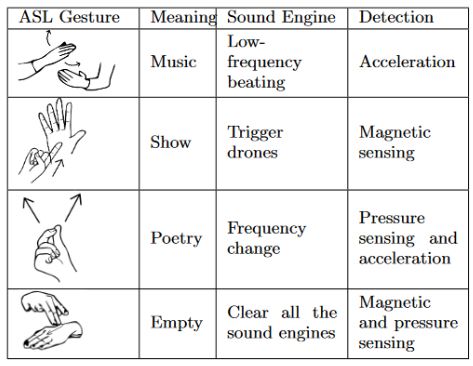Pamela Z Award for Innovation - NIME 2020
The winner of the NIME 2020 Pamela Z Award for Innovation is Doga Cavdir for her paper co-authored with Ge Wang entitled “Felt Sound: A Shared Musical Experience for the Deaf and Hard of Hearing”. In this paper, a musical interface is presented that connects technology, not only for people who are deaf and hard of hearing, but also for those who are not. This year’s conference on New Interfaces for Musical Expression (NIME) 2020 issued the theme of Accessibility of Musical Expression. The Honorary Mention this year is for Patricia Cadavid’s paper named “Knotting the memory// Encoding the Khipu_: Reuse of an ancient Andean device as a NIME”.
Due to COVID-19, the conference has been held entirely online and it was its first time in this format. There have been a number of positive responses and most likely it will have a long-lasting effect on the NIME conference culture. The history of NIME and the Pamela Z Award can be read in detail on last year’s blog post about the Pamela Z award at NIME 2019. In 2018, Astrid Bin, Anna Weisling and Sarah Schoemann co-created the Pamela Z award, which recognises contributions to diversity in the annual NIME conference. The Pamela Z jury this year consisted of Sally Jane Norman, Franziska Schroeder, Anna Weisling, Karolina Jawad and Anna Xambó. The award was co-presented by Sally Jane Norman, as general co-chair of the conference and chair of the jury, and Astrid Bin, as co-founder of the award and co-founder of Bela, the sponsor of this year’s award.
The shortlisted papers especially showed collaborative practises among people with diverse abilities, which would politically reflect on the community, by questioning access, sustainability and equal gender representation. The focus, however, was to highlight works that would make diverse musical perceptions of the world audible, valued and welcomed. Technical skill, artistic merit, and important reflection on wider societal questions were qualities that were found in many contributions. Therefore, the decision was difficult. All nominees closely aligned with the NIME theme of inclusion and accessibility and their contributions will clearly enrich the NIME community in long terms.
The Innovation Award Paper
The musical interface presented in the paper “Felt Sound: A Shared Musical Experience for the Deaf and Hard of Hearing” uses American Sign Language, so non-musical communicative gestures feature as input alongside musical gestures (see Figure 1). It is a movement-based digital music instrument, specifically designed for inclusive performance. It aims to provide a shared musical experience for both deaf and hard of hearing individuals and those who are not. Those hard of hearing are able to physically experience the vibrations, nuances, contours, as well as their correspondences with the hand gestures while those who are not hard of hearing can also experience the sound. The same physical vibrations are shared by everyone. Enabling shared experiences among people with diverse abilities shows how we can benefit from and contribute to increased accessibility, inclusivity, and collaboration.

The Honorary Mention
“Encoding the Khipu_“ is a work that imbues a historical, information processing artefact with tangible computing affordances to elicit narratives that symbolically restore and vindicate ancestral Andean memories. The khipu was an information processing and transmission device used by the Incas and previous Andean societies. According to Patricia Cadavid, Western reading and vision of Khipus would be obsessed with establishing numerical and mathematical logics in them and turning them into codes without a message.

By creating a musical instrument (see Figure 2), Patricia Cadavid is not only sharing her knowledge about old instruments, but is also expanding this numerical logic with musical meaning. Cadavid calls the electronic khipu a tangible live coding interface since the khipu, even transformed into a NIME, would still be a computer and the sound results would vary in real time according to the coding made by the knotwork and the different values produced when the strings are tightened. Its decolonial aesthetic opens NIME up to powerful questions of cultural agency and historical perspectives.
The Prizes and Final Words
A Bela Starter Kit, and a copy of Franziska Schroeder’s edited book “Soundweaving - Writings on Omprovisation” were rewarded to Doga Cavdir. Patricia Cadavid was offered a set of Bela Trill sensors. All in all, we are very happy that the Pamela Z Award for Innovation continued this year and we hope it will do so in the following years. We are thankful to all those who support the initiative and help to make it happen! See you next year at NIME 2021 in Shanghai, China!
References
- Cadavid Hinojosa, L.P. (2020) “Knotting the memory//Encoding the Khipu_: Reuse of an ancient Andean device as a NIME”, in Proceedings of NIME, Birmingham, United Kingdom. p. 495–498.
- Cavdir, D., Wang, G. (2020) “Felt Sound: A Shared Musical Experience for the Deaf and Hard of Hearing”, in Proceedings of NIME, Birmingham, United Kingdom. p. 176–181.
- Schroeder, F., Ó hAodha, M. (eds.) (2014) “Soundweaving - Writings on Improvisation”, Cambridge Scholars Publishing, Cambridge, United Kingdom.
